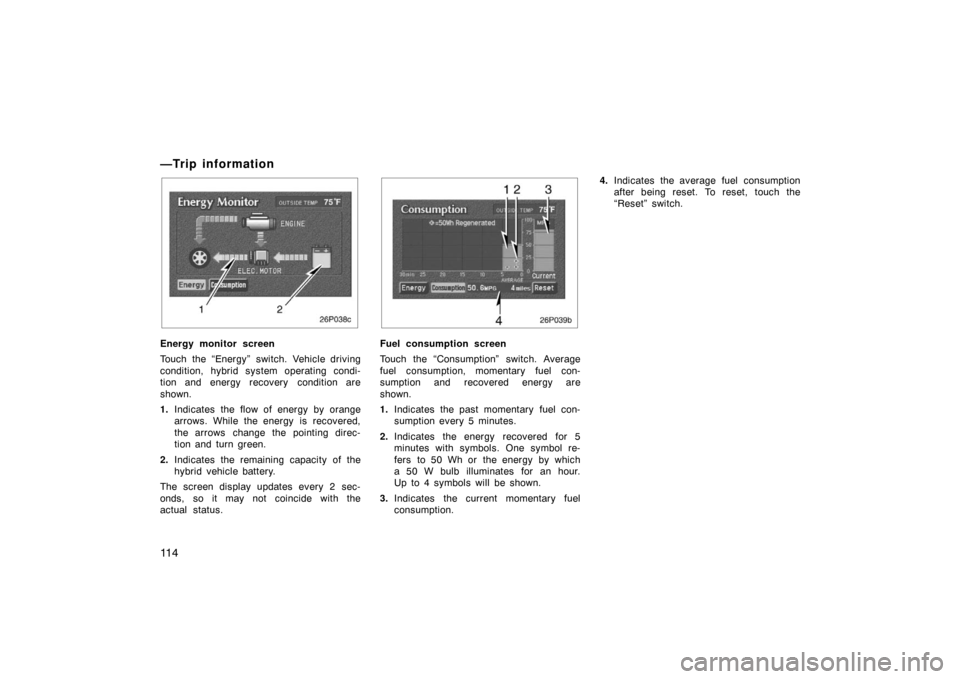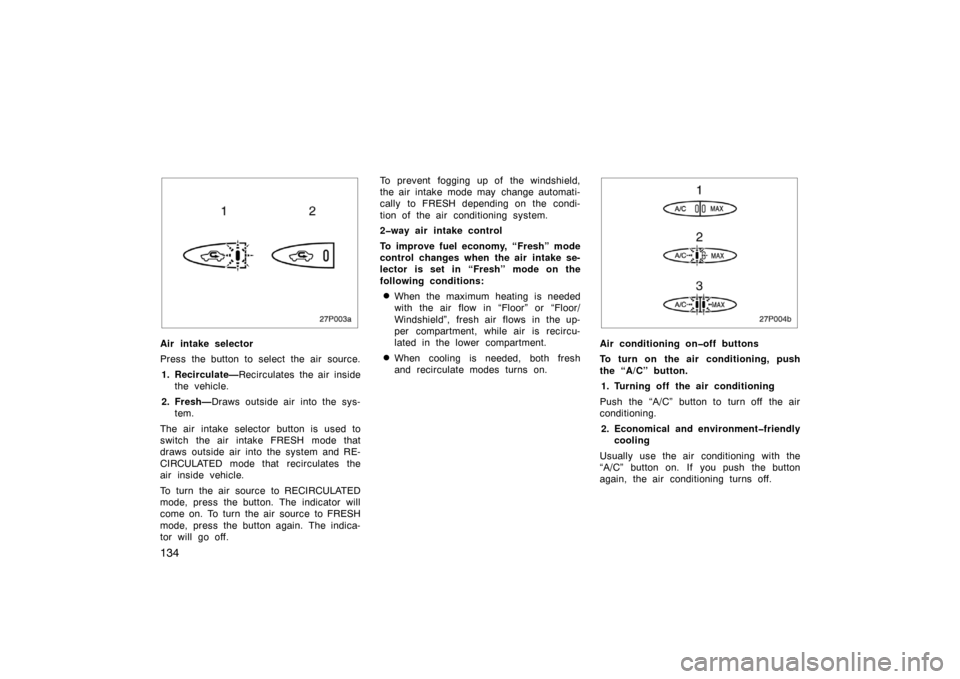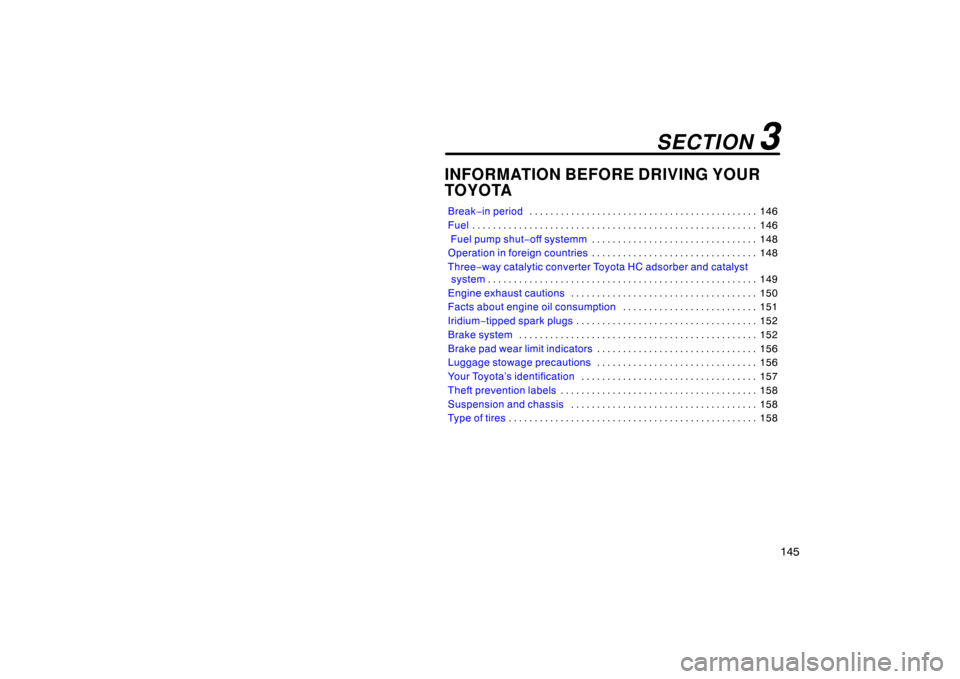Page 125 of 258
11 2
Functions
26p027b
1. Trip information and Screen transi-tion
Fuel consumption and energy monitor on
the hybrid system are shown. For details,
see page 113.
26p026a
2. Adjustment
The contrast and brightness on the screen
are adjusted. For details, see page 115.
24p007a
3. Audio
The radio and cassette tape operations
are available. For details, see page 118.
Page 126 of 258
11 3
24p006b
4. Warning display
The warning symbol for the faulty system
is highlighted. For details, see page 97.
Information
26p009a
Push the “INFO” button to display the
“Information Menu” screen.
26p027b
Trip information: The energy monitor and
fuel consumption screen are selected.
Screen transition: The screen transition
screen is shown.
Page 127 of 258

11 4
—Trip information
26p038c
Energy monitor screen
Touch the “Energy” switch. Vehicle driving
condition, hybrid system operating condi-
tion and energy recovery condition are
shown.
1.Indicates the flow of energy by orange
arrows. While the energy is recovered,
the arrows change the pointing direc-
tion and turn green.
2. Indicates the remaining capacity of the
hybrid vehicle battery.
The screen display updates every 2 sec-
onds, so it may not coincide with the
actual status.
26p039b
Fuel consumption screen
Touch the “Consumption” switch. Average
fuel consumption, momentary fuel con-
sumption and recovered energy are
shown.
1. Indicates the past momentary fuel con-
sumption every 5 minutes.
2. Indicates the energy recovered for 5
minutes with symbols. One symbol re-
fers to 50 Wh or the energy by which
a 50 W bulb illuminates for an hour.
Up to 4 symbols will be shown.
3. Indicates the current momentary fuel
consumption. 4.
Indicates the average fuel consumption
after being reset. To reset, touch the
“Reset” switch.
Page 147 of 258

134
27p003a
Air intake selector
Press the button to select the air source.1. Recirculate— Recirculates the air inside
the vehicle.
2. Fresh— Draws outside air into the sys-
tem.
The air intake selector button is used to
switch the air intake FRESH mode that
draws outside air into the system and RE-
CIRCULATED mode that recirculates the
air inside vehicle.
To turn the air source to RECIRCULATED
mode, press the button. The indicator will
come on. To turn the air source to FRESH
mode, press the button again. The indica-
tor will go off. To prevent fogging up of the windshield,
the air intake mode may change automati-
cally to FRESH depending on the condi-
tion of the air conditioning system.
2�way air intake control
To improve fuel economy, “Fresh” mode
control changes when the air intake se-
lector is set in “Fresh” mode on the
following conditions:
�When the maximum heating is needed
with the air flow in “Floor” or “Floor/
Windshield”, fresh air flows in the up-
per compartment, while air is recircu-
lated in the lower compartment.
�When cooling is needed, both fresh
and recirculate modes turns on.
27p004b
Air conditioning on�off buttons
To turn on the air conditioning, push
the “A/C” button.
1. Turning off the air conditioning
Push the “A/C” button to turn off the air
conditioning. 2. Economical and environment�friendly cooling
Usually use the air conditioning with the
“A/C” button on. If you push the button
again, the air conditioning turns off.
Page 148 of 258

135
3. Powerful cooling and dehumidifying
If the air conditioning does not work well
with the “A/C” button on, push the “MAX”
button. To cancel the “MAX” mode, push
the “MAX” button again. To turn off the air
conditioning, push the “A/C” button.
With the “MAX” button on, the gasoline
engine is frequently used.
The air conditioning may not turn on with
the selector lever in “N” position because
the gasoline engine cannot start.
If the “A/C” button indicator flashes, there
is a problem in the air conditioning system
and the air conditioning automatically
shuts off. If this happens, take your ve-
hicle to your Toyota dealer for service. For economical and environment�friend-
ly use
Usually, use the air conditioning with the
“A/C” button on (economical and environ-
ment
−friendly cooling).
In this mode the gasoline engine starts
and stops automatically and good fuel
economy driving is achieved.
To use the air conditioning in economi-
cal and environment�friendly way, we
recommend the following setting: 1. Lower the setting temperature if you feel a little hot with the “A/C” button
on.
2. If you feel still hot with the “A/C” but- ton on, push the “MAX” button also.
After the compartment cools, turn off
the “MAX” mode only.
Page 158 of 258

145
INFORMATION BEFORE DRIVING YOUR
TOYOTA
Break−in period 146
. . . . . . . . . . . . . . . . . . . . . . . . . . . . . . . . . . . . .\
. . . . . . .
Fuel 146
. . . . . . . . . . . . . . . . . . . . . . . . . . . . . . . . . . . . \
. . . . . . . . . . . . . . . . . . .
Fuel pump shut −off systemm 148
. . . . . . . . . . . . . . . . . . . . . . . . . . . . . . . .
Operation in foreign countries 148
. . . . . . . . . . . . . . . . . . . . . . . . . . . . . . . .
Three −way catalytic converter Toyota HC adsorber and catalyst
system 149
. . . . . . . . . . . . . . . . . . . . . . . . . . . . . . . . . . . . \
. . . . . . . . . . . . . . . .
Engine exhaust cautions 150
. . . . . . . . . . . . . . . . . . . . . . . . . . . . . . . . . . . . \
Facts about engine oil consumption 151
. . . . . . . . . . . . . . . . . . . . . . . . . .
Iridium −tipped spark plugs 152
. . . . . . . . . . . . . . . . . . . . . . . . . . . . . . . . . . .
Brake system 152
. . . . . . . . . . . . . . . . . . . . . . . . . . . . . . . . . . . . \
. . . . . . . . . .
Brake pad wear limit indicators 156
. . . . . . . . . . . . . . . . . . . . . . . . . . . . . . .
Luggage stowage precautions 156
. . . . . . . . . . . . . . . . . . . . . . . . . . . . . . .
Your Toyota’s identification 157
. . . . . . . . . . . . . . . . . . . . . . . . . . . . . . . . . .
Theft prevention labels 158
. . . . . . . . . . . . . . . . . . . . . . . . . . . . . . . . . . . . \
. .
Suspension and chassis 158
. . . . . . . . . . . . . . . . . . . . . . . . . . . . . . . . . . . . \
Ty p e of tire s 158
. . . . . . . . . . . . . . . . . . . . . . . . . . . . . . . . . . . . \
. . . . . . . . . . . .
SECTION 3
Page 159 of 258

146
Drive gently and avoid high speeds.
Your vehicle does not need an elaborate
break−in. But following a few simple tips
for the first 1000 km (600 miles) can add
to the future economy and long life of
your vehicle:
�Do not drive over 100 km/h (62 mph).
�Avoid full −throttle starts.
�Try to avoid hard stops during the first
300 km (200 miles). FUEL TYPE
Your vehicle must use only unleaded
gasoline.
To help prevent gas station mixups, your To-
yota has a smaller fuel tank opening.
The
special nozzle on pumps with unleaded fuel
will fit it, but the larger standard nozzle on
pumps with leaded gas will not.
At a minimum, the gasoline you use
should meet the specifications of ASTM
D4814 in the U.S.A. and CGSB 3.5 −M93
in Canada.
NOTICE
Do not use leaded gasoline. Use of
leaded gasoline will cause the three�
way catalytic converter to lose its
effectiveness and the emission con-
trol system to function improperly.
Also, this can increase maintenance
costs.
OCTANE RATING
Select unleaded gasoline with an Oc-
tane Rating of 87 (Research Octane
Number 91) or higher. Use of unleaded fuel with an octane num-
ber or rating lower than stated above will
cause persistent heavy knocking. If se-
vere, this will lead to engine damage.
If your engine knocks ...
If you detect heavy knocking even when
using the recommended fuel, or if you
hear steady knocking while holding a
steady speed on level roads, consult your
Toyota dealer.
However, now and then, you may notice
light knocking for a short time while accel-
erating or driving up hills. This is no
cause for concern.
GASOLINE CONTAINING DETERGENT
ADDITIVES
Toyota recommends the use of gasoline that
contains detergent additives to avoid build�
up of engine deposits.
However, all gasoline sold in the U.S. con-
tains detergent additives
to keep clean and/or
clean intake systems.
Break�in period Fuel
Page 160 of 258

147
QUALITY GASOLINE
Automotive manufacturers in the U.S., Eu-
rope and Japan have developed a specifica-
tion for quality fuel named World�Wide
Fuel Charter (WWFC) that is expected to
be applied world wide. The WWFC consists
of three categories that depend on required
emission levels. In the U.S., category 3 has
been adopted. The WWFC improves air
quality by providing for better emissions in
vehicle fleets, and customer satisfaction
through better vehicle performance.
CLEANER BURNING GASOLINE
Cleaner burning gasoline, including refor-
mulated gasoline that contains oxygenates
such as ethanol or MTBE is available in
many areas.
Toyota recommends the use of cleaner
burning gasoline and appropriately blended
reformulated gasoline. These types of gas-
oline provide excellent vehicle perfor-
mance, reduce vehicle emissions, and im-
prove air quality. OXYGENATES IN GASOLINE
Toyota allows the use of oxygenate blended
gasoline where the oxygenate content is up
to 10% ethanol or 15% MTBE.
If you use
gasohol in your Toyota, be sure that it has
an octane rating no lower than 87.
Toyota does not recommend the use of
gasoline containing methanol.
GASOLINE CONTAINING MMT
Some gasoline contain an octane en-
hancing additive called MMT (Methylcy-
clopentadienyl Manganese Tricarbonyl).
Toyota does not recommend the use of
gasoline that contains MMT. If fuel con-
taining MMT is used, your emission con-
trol system may be adversely affected.
The Malfunction Indicator Lamp on the in-
strument cluster may come on. If this hap-
pens, contact your Toyota dealer for ser-
vice. GASOLINE QUALITY
In a very few cases, you may experience
driveability problems caused by the partic-
ular gasoline that you are using. If you
continue to have unacceptable driveability,
try changing gasoline brands. If this does
not rectify your problem, then consult your
Toyota dealer.
NOTICE
�
Do not use gasohol other than
stated above. It will cause fuel sys-
tem damage or vehicle performance
problems.
� If drivability problems are encoun-
tered (poor hot starting, vaporizing,
engine knock, etc.), discontinue its
use.
� Take care not to spill gasohol dur-
ing refueling. Gasohol may cause
paint damage.